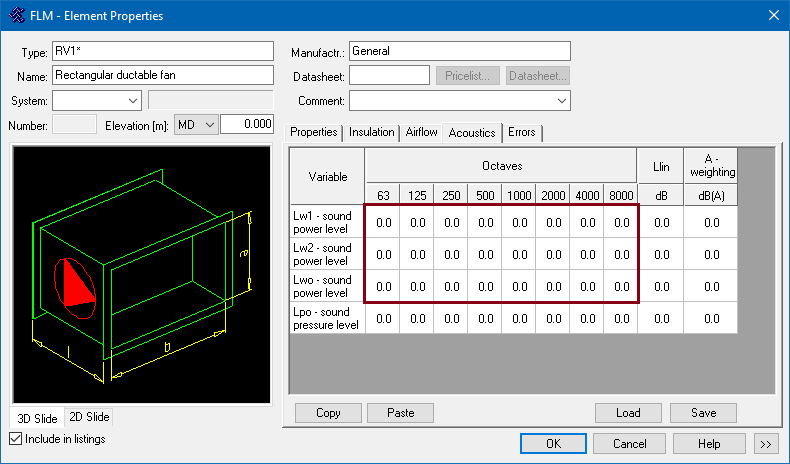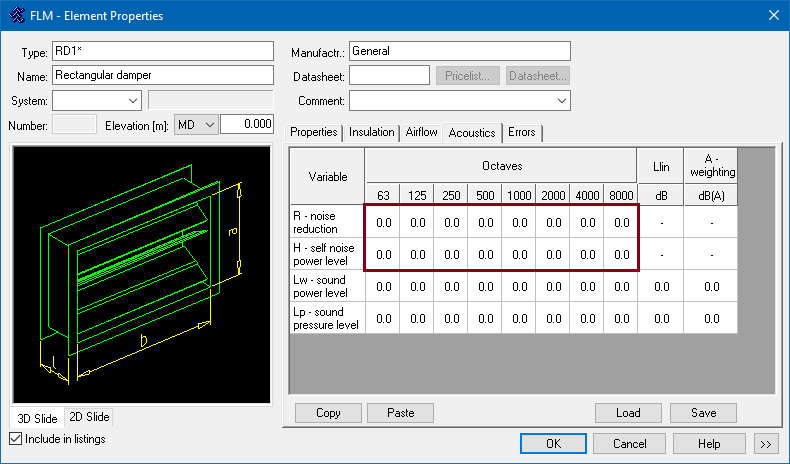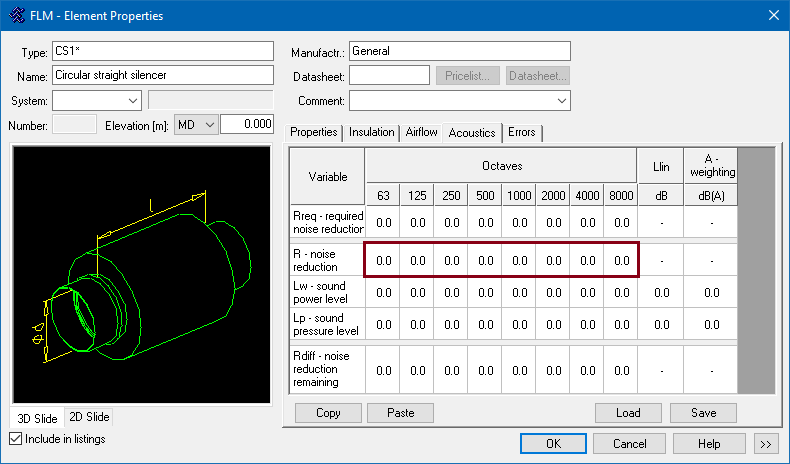Acoustic Calculations are a complex topic and require some expertise / experience to set up and run correctly. This article is intended as a quick reference guide of what You have to be careful of when configuring Your systems in Ventpack. In particular, the most important element types will be discussed: the Fan / AHU, Terminals (Diffusers, Grilles), Dampers and Silencing Elements. The instructions apply equally to both supply and extract (or return) systems!
Fans and Air Handling Units (AHUs)
For Fans / AHUs, please fill the “Sound Power Level” values according to the noise values specified in Catalog / Data Sheets from the Manufacturer. All three rows (“Lw1” / “Lw2” / “Lwo”) may be the same. While those values are intended for the supply-side, extract-side and fan body noise values, respectively, currently only one of them (“Lwo”) is actually taken into account by the software for calculation purposes. This will be corrected in a future version of the software.

Terminals, Dampers, Accessories
For Terminals (Diffusers, Grilles, etc.) and Accessories (Dampers, Heaters, Filters, etc.), please fill the “Noise Reduction (R)” and “Self-Noise Power Level (H)” values, according to the appropriate data values, as provided by the Manufacturer in the documentation for each specific product.

Silencers / Noise Attenuators
For Silencers / Noise Attenuators, please fill only the “Noise Reduction (R)” values according to the performance values as reported by the Manufacturer.

Octaves versus Llin and A-weighted values
The “Llin / dB” and “A-weighting / dB(A)” values are combination / averaged Sound Power and Pressure Level values that reflect the overall loudness without regard to the frequency. The first value averages the octaves equally, while the A-weighted value also considers the so-called A-curve reflecting the relative sensitivity of the human ear to different frequencies. You do not need to specify these values, as both are calculated automatically based on the provided or calculated octave-level values. Note the use of standard octave middle frequencies: 63 Hz, 125 Hz, 250 Hz, 500 Hz, 1 kHz, 2 kHz, 4 kHz and 8 kHz. Please see https://en.wikipedia.org/wiki/A-weighting for more information about the A-curve.
Note on Negative Decibel Values
Decibel (dB) values are always logarithmic: dB = 10 * log10 X. In the case of Noise Reduction, values combine through multiplication, meaning that Decibel values are ADDED. Positive Noise Reduction values shown in the program reduce noise: 20 dB means 1 / 100 resulting Sound Power or Pressure, while – 20 dB would mean 100 times the original (incoming) value. For Self-Noise Power or Pressure Levels, the Decibel values CAN NOT be added directly!! Instead, resulting Decibel values that correspond to sums of independent sources have to be obtained through a sum of the exponentiated input Decibel values:
dBsum = 10 * log10 [ 10 ^ ( dB1 / 10 ) + 10 ^ ( dB2 / 10 ) + … + 10 ^ ( dBn / 10 ) ]
This means that for Self-Noise, negative Decibel values correspond to very small, practically negligible Power or Pressure values that leave no effect in the sum above! In a future correction to the program we plan to change behavior so that such values are shown as simply 0 or as “< 1 dB”.
